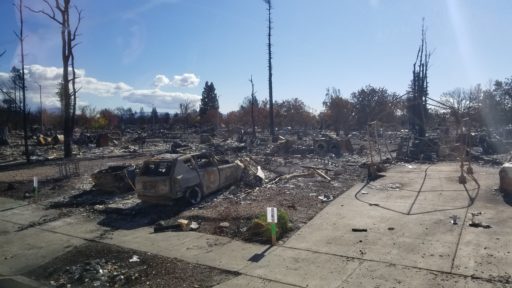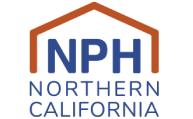Sonoma County, City of Santa Rosa, Burbank Housing and the Federal Reserve Bank hosted a tour of fire damaged sites on November 6. NPH traveled to North Bay to join our members, partners, and allies for this tour, followed by a Recovery Roundtable to discuss opportunities for next steps and solutions.

Debris from the North Bay fires. For more images from our tour, click here.
Supervisor James Gore narrated the tour for 50 participants including elected officials, community leaders, affordable housing developers, and philanthropic and finance representatives. Burned out homes and the Journeys End mobile home park suffered heat up to 1600 degrees, melting aluminum car parts and window glass. Gore described the organizing principles as Response, Recovery, Rebuilding, and Resiliency and highlighted recent County urgency measures to protect renters and speed redevelopment.
EPA crews are now removing propane tanks, pesticides and other toxics.
“At the close of the tour, we could see where the fire jumped Highway 101,” said NPH Executive Director Amie Fishman. “To get the community back on its feet, we will have to move as fast as the fire did, but bring positive change and collaboration instead.”
Community leaders lead critical conversation during the Recovery Roundtable
We are all concerned about the affordable housing options that will remain for our Northern California communities. Even before the fires, this region suffered a shortage of affordable homes: Sonoma County in 2016
needed more than 17,000 affordable homes already.
The Wildland / Urban Interface, where the fire was most destructive, took 3,000 homes inside the city limits of incorporated Santa Rosa alone. An experienced labor force will be required to complete demolition, debris removal, and rebuilding. Some areas in the unincorporated can be rebuilt with new sewer hookups and greater density and affordability protections.
County Community Development Commission executive director Margaret Van Vliet noted that the fire did not observe jurisdictional lines and rebuilding will also need to follow “more, better, faster, safer” as guiding principles. She thanked state and federal officials for their immediate response and coordination, and called for inclusion and equity into all efforts. “We’ll need to be marshaling resources to deliver housing for all, with creative partnerships for a resilient community,” she said.
Supervisor Shirley Zane called on financial institutions to “take risks and operate on non-profit values so we can get people back in their homes.” Santa Rosa Mayor Chris Coursey and planning director David Guhin described efforts to expedite rebuilding, while encouraging increased density and resiliency opportunities where feasible. There are currently 4,500 units in the pipeline with maybe 500 affordable homes planned — but stalled — for lack of financing.
Local architects and builders are working to create a consortium of lenders, builders, and homeowners to coordinate and streamline rebuilding of single family home subdivisions quickly and cost effectively. There is increased interest in affordable homes, particularly along the SMART train corridor.
The Roundtable concluded with brainstorming of financial capacity, investment and credits needs. Banks and community development financial institutions explored ways to bring needed capital into the community.
NPH remains committed to continuing conversations with our Northern California members, partners, and community leaders to understand the full impact of the North Bay fires and how we can offer response and recovery for the families and individuals displaced by the wildfires — both for the short- and long-term housing needs of our communities. We will continue bringing updates and information as we understand it.



